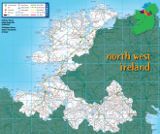North West Ireland Tourism
Visitor Guide to Mayo, Sligo, Donegal, Roscommon, Leitrim, Cavan & Monaghan
Visitor Guide to Mayo, Sligo, Donegal, Roscommon, Leitrim, Cavan & Monaghan
| 0-9 A B C D E F G H I J K L M N O P Q R S T U V W X Y Z |
Raghly Harbour
When Raghly Harbour was completed 180 years ago, its new stone quays walls encircled a protected dock of almost one acre, a very large expanse of water by any standard. And yet it cost just £1606, a modest construction by the standards of its famous designer-engineer Alexander Nimmo. It was Nimmo who designed most of the handsome lighthouses which encircle Ireland. Indeed his name has become synonymous with good architecture, robust engineering, and his very own brand of vernacular lighthouse styling. And here in Raghly Harbour Nimmo’s legacy is once again gifted to us in the simplicity of his work and the honesty of its construction. These days Raghly Harbour is greatly underused. It supports just a small fishing fleet of lobster and crab boats, and a sprinkling of recreational boats during the summer season.
To the east of Raghly Harbour and its nearest neighbour, Ballymulderry, is Lissadell House, one of the great stately houses of ireland. This neo-classical country house was built in the 1830′s as the home of the Gore-Booth family. It was the childhood home of the Irish revolutionary Constance Gore-Booth, her sister the suffragist Eva Gore-Booth, and their brother Josslyn Gore-Booth. Constance was one of the leaders of the 1916 Rising, and was the first woman to be elected to Dail Eireann where she served as Minister for Labour (becoming the first woman minister in a modern European democracy). She was also the first woman to be elected to the British House of Commons although she declined to take her seat. Eva was a poet of great distinction and an active suffragist who clashed fiercely with Winston Churchill, then a young man, over barmaids rights in 1908. At Lissadell, Josslyn Gore-Booth created one of the great horticultural estates of Europe and his life’s work can now be enjoyed and appreciated by all who visit.
Book Raghly Harbour Accommodation
The light of evening, Lissadell
Great windows open to the south
Two girls in silk kimonos, both
Beautiful, one a gazelle. …
Many a time I think to seek
One or the other out and speak
Of that old Georgian mansion, mix
pictures of the mind, recall
That table and the talk of youth,
Two girls in silk kimonos, both
Beautiful, one a gazelle.
.
W. B. Yeats
To the east of Raghly Harbour and its nearest neighbour, Ballymulderry, is Lissadell House, one of the great stately houses of ireland. This neo-classical country house was built in the 1830′s as the home of the Gore-Booth family. It was the childhood home of the Irish revolutionary Constance Gore-Booth, her sister the suffragist Eva Gore-Booth, and their brother Josslyn Gore-Booth. Constance was one of the leaders of the 1916 Rising, and was the first woman to be elected to Dail Eireann where she served as Minister for Labour (becoming the first woman minister in a modern European democracy). She was also the first woman to be elected to the British House of Commons although she declined to take her seat. Eva was a poet of great distinction and an active suffragist who clashed fiercely with Winston Churchill, then a young man, over barmaids rights in 1908. At Lissadell, Josslyn Gore-Booth created one of the great horticultural estates of Europe and his life’s work can now be enjoyed and appreciated by all who visit.
How to get to Raghly
By bus, or car. Take the N15 north from Sligo to Drumcliff, and then follow local roads to Raghly Point. From Donegal take the N15 south to Grange, and then local roads to Raghly Point.Where to stay near Raghly Harbour
Raghly Harbour has lots of great accommodation options nearby including hotels, self-catering holiday homes, guesthouses and B&B's.Book Raghly Harbour Accommodation
Explore More
Raghly Harbour is surrounded by beautiful coastal towns. Don't miss Mullaghmore and Ballyshannon if you are travelling north, and don't miss Rosses Point, and Sligo, if you are travelling south.Things to do in Raghly Harbour
You just have to visit Lissadell House! Lissadell is famous as the childhood home of Constance Markievicz, her sister Eva Gore Booth and her brother Josslyn Gore Booth. Constance was one of the leaders of the 1916 Rising, and was the first woman to be elected to Dail Eireann, where she served as Minister for Labour (thus becoming the first woman minister in a modern European democracy), and was also the first woman to be elected to the House of Commons at Westminster, London (where she declined to take her seat). Eva was a poet of distinction and an active suffragist, clashing with the young Winston Churchill over barmaids’ rights in 1908. Josslyn created at Lissadell one of the premier horticultural estates in Europe. This horticultural enterprise has now been recreated at Lissadell. Sligo born poet W. B. Yeats was friendly with the Gore Booth sisters and stayed at Lissadell in 1893 and 1894. He immortalised Lissadell and the Gore Booth sisters in his poetry:The light of evening, Lissadell
Great windows open to the south
Two girls in silk kimonos, both
Beautiful, one a gazelle. …
Many a time I think to seek
One or the other out and speak
Of that old Georgian mansion, mix
pictures of the mind, recall
That table and the talk of youth,
Two girls in silk kimonos, both
Beautiful, one a gazelle.
.
W. B. Yeats






